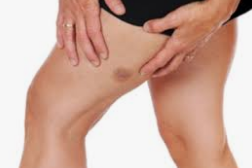Pressure Ulcers MCQs :-
1. The wound is located in skin folds; the edges are diffuse and irregular; the depth is partial thickness; there is no necrosis. This wound is likely:
- Incontinence associated dermatitis (lAD)
- IQ Pressure ulcer (PU)
2. Pressure ulcers tend to develop when the skin is dry.
- True
- False
3. Intrinsic factors that cause pressure ulcers are those in the patient’s immediate environment that place him or her at risk of developing pressure ulcers.
- True
- False
4. In which category / stage of pressure ulcer is the depth of the wound bed unknown?
- Category I Stage I
- Category I Stage II
- Category I Stage III
- Category / Stage IV
- Suspected deep tissue injury
- Unstageable
- None of the above, this is normal skin
5. Infection increases the pressure needed to cause tissue necrosis.
- True
- False
6. What occurs when the skin is rubbed against an external surface?
- Friction
- Continuous pressure
- Shear
- Force
7. The greatest risk factor for pressure ulcer development is:
- Incontinence
- Malnutrition
- Immobility
- Advanced age
8. Which of the following are at risk for developing pressure ulcers?
- Bedridden patients
- Stroke victims
- Patients with diabetes
- Malnourished seniors
- All of these
9. Exposed bone, tendon or muscle is a characteristic of what pressure ulcer stage?
- Stage I
- Stage II
- Stage III
- Stage IV
10. Older adults have more lean body mass and more subcutaneous tissue to cushion bony areas.
- True
- False

11. Low blood pressure may contribute to pressure ulcer development.
- True
- False
12. The most common sites for pressure ulcers in intensive care unit patients are:
- Ears and knees
- Sacrum and heels
- Elbows and hips
- Shoulder blades and wrists
13. Undermining and tunneling are common at what pressure ulcer stage?
- Stage i
- Stage II
- Stage III
- Stage IV
14. Which of the following causes much of the damage often observed with pressure ulcers?
- Force
- Friction
- Shear
- Continuous pressure
15. What is a common cause of underlying tissue not receiving an adequate blood supply?
- Continuous pressure
- Shear
- Force
- Friction
16. What category / stage of a pressure ulcer is
characterized by partial thickness loss of dermis presenting as a shallow open ulcer with a red pink wound bed, without slough?
- Category / Stage I
- Category / Stage II
- Category / Stage III
- Category / Stage IV
- Suspected deep tissue injury
- Unstageable
- None of the above, this is normal skin
17. What category / stage of a pressure ulcer is characterized by intact skin with non-blanchable redness of a localized area usually over a bony prominence?
- Category /Stage I
- Category /Stage II
- Category /Stage III
- Category /Stage IV
- Suspected deep tissue injury
- Unstageable
- None of the above, this is normal skin